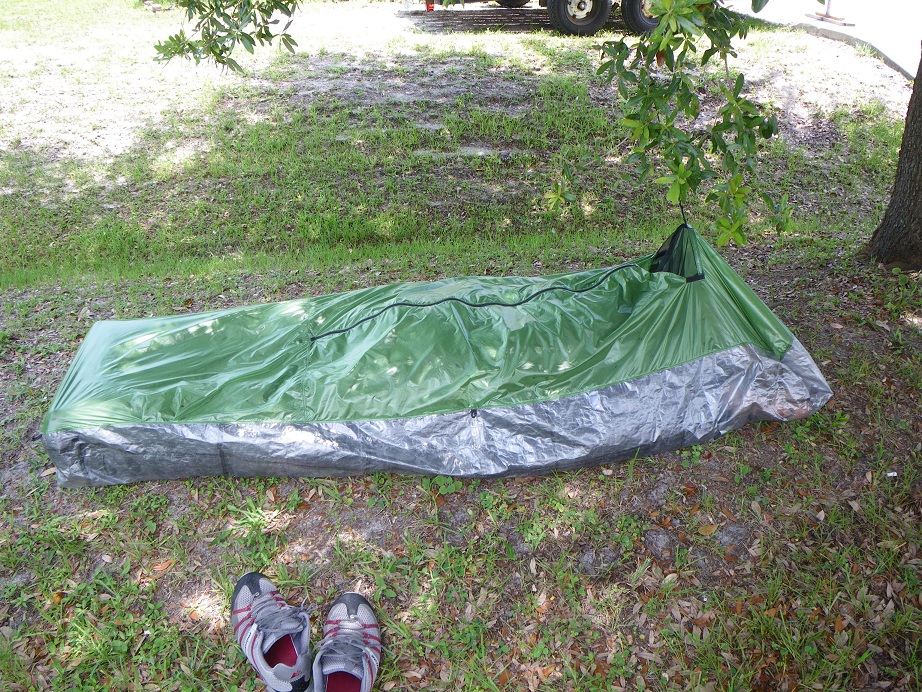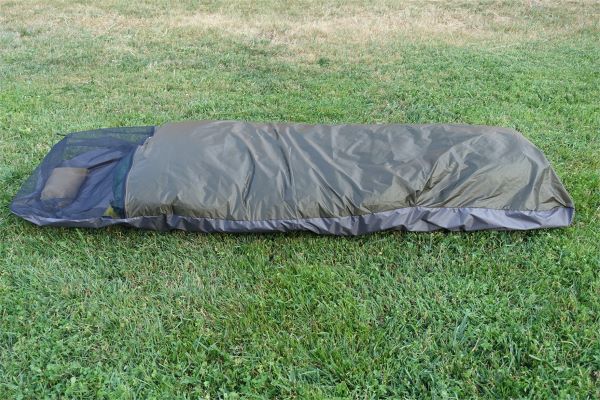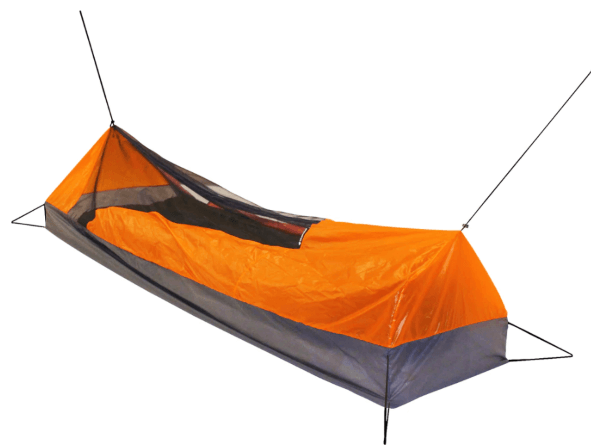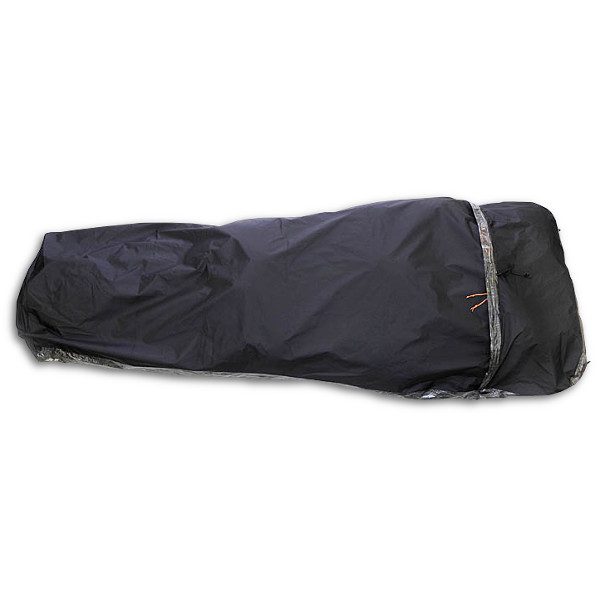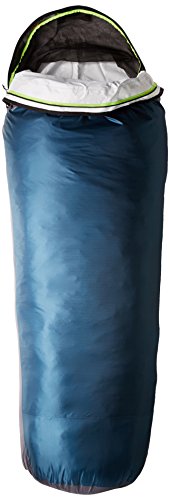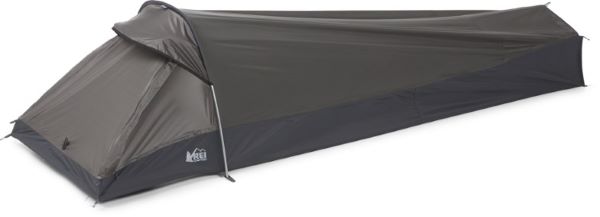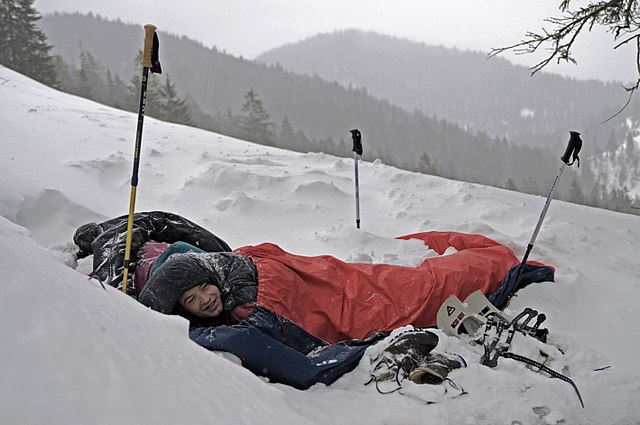
I remember the first time I learned about bivy sacks. At Appalachian Trail Days in Damascus, VA someone was telling me about various lightweight shelter options. Bivy sacks came up, naturally, and they intrigued me immediately.
More...
Bivy sacks are tiny little cocoons that protect the hiker and their sleeping bag with almost nothing else for shelter. They’re used by emergency crews, mountaineers, and some extreme athletes who need minimal weight and bulk. That doesn’t mean a bivy sack can’t be for the average Joe hiker, though!
If you’re looking to get away from traditional backcountry shelters, like tents, and into an ultralight fast-moving option, bivies might be for you. Fortunately, I’ve spent hundreds of nights on the trail guiding backpacking trips so I can help you compare and contrast these tiny shelters.
Let’s take a deeper look at what bivy sacks are (and are not), who they’re best for, and which bivy sacks make good choices for you.
Comparison Chart
Name | Price | Weight | Rating | Notes |
|---|---|---|---|---|
$$$ | 5.8 oz | A small 5" x 6" Cuben Fiber stuff sack is included in the price and weight | ||
$$$ | 5.5 oz | The proprietary fabric lets moisture escape at the same time that it keeps rain, snow, and wind on the outside | ||
$$$ | 7 oz | Silicone-coated fabric top blocks wind, dew, spindrift and precipitation, making it the perfect emergency shelter | ||
$$$ | 6.4 oz | The zipper goes across the chest just like on the Standard, but then takes a turn down the left side for 24", creating a bivy that is easier to get into. | ||
$$$ | 6.35 oz | With no-see-um mesh panels over the head and torso, the Recon boasts excellent ventilation and moisture control. | ||
$$$ | 12 oz | eVENT fabric foot box (black color) end panel is ergonomically shaped for foot comfort | ||
$$$ | 32 oz | Delrin Single-Pole System | ||
$$$ | 18 oz | The Helium Bivy is the lightest bivy that Outdoor Research makes | ||
$$$ | 1 lb 6 oz | Waterproof, breathable Pertex® nylon top shell and waterproof, abrasion-resistant ripstop nylon floor are both seam-sealed for true waterproof protection | ||
$$$ | 15.2 oz | Dual zippers with hook-and-loop tabs allow for 'arms out' functionalityDual zippers with hook-and-loop tabs allow for 'arms out' functionality |
How to Choose Your Next Bivy Tent
What, exactly, is bivouacking?
Before we dive too deep into the weeds, let’s first make sure we’re all on the same page.
A bivouac, or bivy sack (also: bivy tent), is actually an old word describing a temporary encampment of soldiers made without tents or cover (definition). In fact, the word’s origins are likely deeply Germanic and once referred to a guard or patrol of citizens who protected a town at night!
Today, however, bivouacking refers to the act of camping in a bivy bag. These bivy bags are usually waterproof sleeves that leave just enough room for the sleeper, camping pad, and sleeping bag inside (with breathing room).
Note: I will use various different terms for “bivies” in this article. They all refer to the same thing, I’m just trying to get you used to hearing various terms you may encounter.
Advantages of Bivouacs
Bivy tents have a few major advantages over the “standard” tent.
Disadvantages of Bivouacs
Bivy bags, while they excel in some areas, come with a few major drawbacks. Mostly the drawbacks are concerning their space constraints.
Who Should Use a Bivy
Alright, first of all, let’s start by saying that I can’t make this decision for you. However, I can lead you to think about when and where bivies usually make sense.
Let’s go over the facts: bivies are lightweight, small, claustrophobic, minimalist shelters.
Unless you have another type of shelter nearby, there’s nowhere to cook out of the wind or rain. There’s nowhere to change your clothes if you might need any privacy.
However, they are about the smallest lightest shelter option available to anyone.
So, if lightweight and minimal bulk are top priorities for you and you can tolerate a claustrophobic shelter with nowhere to do your daily tasks then bivies are perfect.
Many ultralight hikers are more than willing to make these sacrifices for a lightweight shelter though and that’s great!
Just keep in mind that there are some functional drawbacks to bivies as well – not just comfort. Remember that condensation that collects on the inside of your tent during the night? In a bivy that condensation can collect directly on to you and your sleeping bag!
But let’s be real – every type of shelters has pros and cons. So it boils down to deciding if the benefits outweigh the potential drawbacks for you.
Types of Bivy Setups
There’s a lot to know about bivies and how you can use them. In fact, new methods are being pioneered by smart hikers all the time!
For now, though, I’ll explain a couple common methods I know bivy users employ to stay dry and warm.
Bivy With a Tarp
Some hikers use a lightweight bivy underneath a tarp as a bug or water protection layer.
The tarp is your first layer of protection and provides more room to change clothes, eat, or move around without getting soaked. Your bivy adds an extra measure of security, ensuring that you and your sleeping bag or quilt are protected from splash-over and bugs!
Bivy as a Standalone Shelter
Some fully waterproof bivies are used as a standalone shelter. There’s no extra tarp or tent needed – you just put your bag inside the bivy sack and climb in with it.
This method is the most claustrophobic and present logistical problems. For instance – how do you get into your bivy and sleeping bag while it’s raining (and you’re wet) without getting everything soaked?
Bivy Inside a Snow Shelter
For winter touring some people choose to construct snow shelters. By burrowing down into the packed powder, ski tourers and mountaineers can make a group-sized shelter out of the snow itself!
A lightweight bivy can protect the sleeper and sleeping bag from any moisture or melting snow during the night inside a snow shelter.
Types of Bivy Fabric
Nylon
Nylon is used in almost every bivy bag construction. Even waterproof breathable fabrics use a nylon (sometimes polyester) outer layer as an integral part of the construction of the bivy.
Nylon comes in some many weaves, cuts, and variations that you’ll find it called dozens, if not hundreds, of proprietary names. What it boils down to is a water-resistant, windproof (usually) fabric that is highly abrasion resistant.
Polyester
Similar to nylon in many ways, polyester will occasionally see use in bivies. Depending on many factors polyester can be a good competitor to nylon for use in bivies.
Cuben Fiber
Cuben fiber, now called Mylar Composite, is a totally waterproof non-breathable lightweight fabric. Originally used in cutting-edge racing sails, this fabric is made with a layer of Dyneema fibers sandwiched between two layers of plastic called mylar.
When done properly, cuben fiber fabric can be heat welded for a strong, perfectly waterproof seam that uses no sewing. On top of that, it is many orders of magnitude lighter than the closest competitors.
The downfall is that Mylar Composite fabric is not breathable, it’s very expensive, and it’s prone to puncture damage.
Gore-Tex
A form of waterproof breathable fabric, Gore-Tex is one of the most popular and proven WPB fabrics available. Gore-Tex I think makes a good choice for those who prefer a reputable brand name and don’t mind paying for the name.
Today there are many different brands of WPB fabric.
eVent
This fabric always makes an appearance on my lists because I love it. Why? It’s a waterproof breathable membrane fabric that has many times the breathability of similar fabrics.
Granted I haven’t seen any research from fabrics this year, but the last I checked, eVent was actually the most “breathable” of all WPB fabrics.
Bivy Bag Weight
Since we’ve already established that bivies can be used in more than one way it stands to reason that they probably vary in weight.
From lightest to heaviest bivies usually fall into this order:
One factor that will dramatically affect weight is the uses of WPB fabric. This stuff is just heavy but in the case of bivies, it’s one of the only viable options to keep out water without drowning the user in condensation.
Another weight factor is the use of poles to suspend the fabric above the face. This can sometimes be sidestepped by using an elastic shock cord tie-out to pull the fabric up and away instead of a pole.
To compare a tarp+bivy system to a standalone bivy I’ll show you one example of weight:
- Zpacks Pertex Bivy + UGQ 12×12 Tarp = 29.8 Ounces
- Outdoor Research Alpine Bivy = 32 Ounces
Of course, a tarp won’t work for all people in all situations. But this goes to show that a tarp, with significant room (12’x12′) plus a bivy, can be as lightweight as just a bivy! And, man, is that extra space nice when it’s raining and you need room to do stuff.
Bulk
Bivies are much less bulky than almost any other shelter type. I mean, they’re pretty much just a cocoon of fabric that’s little bigger than a sleeping bag.
So, what factors can ensure that you keep that low bulk as minimal as possible?
I would say that you need to consider using a quilt instead of a sleeping bag. That will help a lot with minimizing bulk.
On the side of the bivy tent itself, you’ll do best to go with a tarp+bivy to maximize versatility with the least bulk. This also means you can skip the bivy poles and of course, tarps don’t need poles either.
As far as bulk is concerned, there are many ways to reduce bulk in a backpack. Using a bivy is already a step in the right direction and a good bivy is about as minimal as it gets.
When to Use Bivy Sacks
Bivy bags are, without a doubt, a niche backpacking shelter. These shelters are wildly lightweight, compact, and minimalist. They’re ideal for people who need to move fast, stay agile, and can get away with the bare minimum in terms of shelter comforts.
Bivy sacks are popular among mountaineers who may use them to pare down weight and bulk on an already large and heavy load of gear. Search and rescue teams also tend to gravitate toward bivies. Since most SAR operations don’t require the use of shelter and hinge on fast, lightweight movement a traditional shelter wouldn’t make sense. Bivies, on the other hand, are small and light enough to be used as a backup or to keep the team moving in overnight scenarios.
Likewise, ultralight or super-fast athletic backpackers love bivies. People pushing their limits or pressing on in an attempt to set speed or distance records often love bivies (if they use shelter at all). Bivies, again, are small and light enough to keep these speed junkies moving while still staying safe during inclement nighttime weather.
Bivies are, essentially, the tool of choice for those who don’t care about nighttime comfort but instead want the lightest possible option for overnight shelter safety.
In my experience, most “average” backpackers prefer a little more comfort and are willing to carry the extra weight and bulk of a more traditional shelter. There are many super-lightweight tarps, tents, and hammocks out there that are much more comfortable and convenient for the average weekend-warrior backpacker than a minimalist bivy.
Best Bivy Tents for Backpackers
As a tarp+bivy combination, you’re not going to find a lighter, higher quality bivy than this one. ZPacks is well known for their attention to detail and relentless pursuit of ultralight gear.
- Waterproof bathtub floor
- The top zipper can act as a vent
- Detachable bug screen
- Weight: 5.8 Ounces
Unlike the OR bivy, the ZPacks bivy uses an elastic cord and a loop to hold the fabric away from your face. This eliminates the need for a pole altogether and lightens the load.
However, let’s be clear that this is not a fully waterproof standalone bivy. It’s ideal for keeping running or splashing groundwater off of you while you sleep under a tarp.
At just 18% of the weight of the Alpine Bivy though this is certainly one of the most ultralight bivy bags for backpackers. Just remember that to compare it to the OR Alpine Bivy you need to factor in the weight of your waterproof tarp as well.
For bug resistance or adding to a tarp, it’s almost impossible to beat this bivy for weight.
This one is a little less robust than some other options on our list. However, it still makes a great choice for a tarp+bivy option!
- Water resistant fabric
- Windproof
- Reflects body heat radiation
- Weight: 5.5 Ounces
If you’ve ever seen or used those aluminum survival blankets, you already understand how this works. Instead of a heat reflective plastic, however, this windproof fabric does the same job.
While it’s not technically waterproof, it is highly water resistant and that’s all you need most of the time for underneath a tarp.
Thanks to the lightweight, packable size, and insanely affordable price tag it’s pretty hard to ignore this bivy as a competitor for using in addition to other shelters like a tarp.
It also provides some flexibility to users because during warm months you could use this alone for a summer bag, with a quilt on cold nights, or use just the quilt if the weather is right.
Unlike the REI Superlight, the MSR E-Bivy has absolutely zero comfort features. It’s feather-light and extremely minimalist. In fact, they’ve pared it down so much that it just might be a little too minimalist.
- No frame
- Water-resistant
- Weight: 7 ounces
This bag is made with 15-denier (very light) ripstop nylon. It’s treated with Xtreme Shield waterproofing (no idea what that means) but only on the floor. For rain protection, it has a “silicone-coated” fabric that’s supposed to block wind, dew, spindrift, and “precipitation”.
If you didn’t catch that, this bivy isn’t made to stand up against serious weather by itself. That’s not a bad thing, however. The bottom is waterproof so it’ll save you from ground run-off. On top, you get a little minor water resistance which could be great paired with a light tarp or another shelter.
I’ve used trash bags before to cover my sleeping bags when tarp camping in heavy winds. This bivy is a big upgrade from random waterproof garbage!
Best for pairing with other shelters or minor protection from dewy nights under the stars.
Borah gear is a small cottage industry company that makes some awesome gear. There’s no doubt that their Argon series will put any bivy on our list to the test in terms of weight.
- Open head net
- Partial side zipper
- Weight: 5.6 ounces
In the same class as the Zpacks Pertex Quantum bivy, this feather-light bivy is a sweet deal. Now, don’t be fooled, it’s not going to stand up to a downpour on its own. On a buggy, dewy night, however, it’s the perfect ultralight companion.
One of the nice things about ordering from Borah Gear is that you can customize your gear. They’ve got various lengths depending on your height. Also, you can choose a regular or wide size if you want or need more space.
This is a solid pairing if you use a tarp for weather protection and need that extra protection from bugs or water spray.
One of the drawbacks is that you’ll need to order ahead. Like most small backpacking companies, all their gear is handmade to order so be prepared for a lead time.
Let’s keep rolling with the super lightweight, high quality gear you can only find from the cottage manufacturers. With comfort features I can’t believe make it in at just 6.35 ounces, this bivy deserves a strong look from anyone seeking a solo shelter option.
- Waterproof bathtub floor
- Hanging net for space
- Weight: 6.35 ounces
If you’re looking for something to keep out water spray, rain runoff, and bugs under your tarp this is the bivy for you. It’s made to be hung using the tie-outs so you have tons of space and comfort. Tie up your tarp, hang the bivy under it, and you’ll be fully protected in a flexible, lightweight solo shelter.
You can also order a fully custom bivy made with any color fabric you want when you get ready to buy from Enlightened Equipment.
Maybe the most stand-out feature on this bivy is the generous size of the bug net. They’ve left a ton of room for view and air so if you feel claustrophobic this is the bivy for you.
Mountain Laurel Designs is a company, like ZPacks, focused on light, fast, and cutting edge. They’re one of the original makers in the space of “ultralight” cottage industry gear, and they remain a great maker.
- Fully waterproof bivy
- No way to keep it off your face
- Made with eVent fabric
- Weight: 12 Ounces
While Gore-Tex remains the most recognized name in waterproof breathable fabric, the last time I checked eVent fabric actually outperforms Gore-Tex. EVent fabric can release more moisture per square inch than almost any other waterproof breathable material!
While there’s no pole for the face, there is an overhead hang loop which you can use with string or shock cord to keep the fabric off your face.
You can easily open the face to allow some fresh air in with a mesh screen. Plus, near the head of the bivy is some extra space to store a little gear though it won’t be enough for a full backpack.
It’s worth noting that the floor of this bivy is made with Cuben Fiber which is a very lightweight but puncture-prone waterproof material. Some hikers love cuben, others stay away from it due to its high price and potential fragility.
If you want a standalone bivy shelter, there are very few out there more robust and well-loved than the OR Alpine Bivy. It’s roomy, waterproof, and can be fully sealed up against wind, rain, or snow.
- Gore-Tex waterproof breathable
- Can be staked out
- Single pole system to keep fabric off your face
- Weight: 32 Ounces
Let’s be honest, you’d have to be sleeping through a hurricane before water is going to leak into this bivy. The entire thing is made from seam-sealed Gore-Tex and the zippers are covered by flaps that overlap generously to shed water.
You also can set the bivy up using tent stakes or tying out the loops. Plus there’s a single looped pole that provides structure (and breathing room) to the front of the bivy.
Overall this bivy is ideal for a standalone shelter and has enough room for a large pad and high-loft sleeping bag.
For a lightweight standalone bivy, OR took aim directly at the heart of what users need. With some quarreling in the reviews, however, users seem to have mixed experiences.
- Waterproof/breathable lightweight fabric
- Overhead pole to add structure
- Can be staked out
- Weight: 18 Ounces
Compared to the OR Alpine Bivy, the Helium is indeed lighter by about 44%. That’s thanks to the lightweight Pertex Shield+ fabric which OR claims is highly breathable.
Users seem to find that the bivy has more condensation issues than some other similar bivies though. I’m left wondering if people are using it wrong, or just expecting too much? Fact is, condensation will always be an issue with bivies to some degree.
This bivy can be used fully sealed for waterproof and windproof protection, or you can open the flap near your face to watch the stars through the mesh no-see-um screen.
Overall, I think this is a good lightweight alternative to a standalone bivy system if you can figure out its quirks.
We would be remiss if we talked about today’s best bivy bags without looking at the REI in-house brand bivy. REI’s gear is usually a great value for what you get and what you spend. Did they keep the trend going with their foray into bivies, though?
- Single arched frame
- Waterproof breathable Pertex
- Weight: 22 ounces
Honestly, what they’ve done is given us a super-tight, lightweight single person tent. This bivy gets staked out and uses a single arched pole for headroom. Once setup, you can open the bug net head area for a less claustrophobic feel or leave it closed when it rains.
At 22 ounces, however, it’s far from ultralight. They’ve taken the bivy bag, added a few comfort features of your standard tent, and create a blend of the two.
All that said, this bivy might make a good choice for someone looking for a lightweight, compact solo shelter that blends the best of both worlds.
If you want to fly under the radar, nothing beats a camo bivy. Slumberjack delivers a super slim, visually low-profile, waterproof bivy that won’t break the bank with this one.
- Camo color
- Hooded design
- Weight: 15 ounces
Maybe the most standout feature on this bivy is the arm-through slots. Unzip the top of the bivy and you can slide your arms out without fully unzipping the bag. It’s a great way to grab your headlamp, take a drink of water, or find something in your bag without getting out of your bivy when the weather is nasty.
It is a very slim profile bivy, but they did go ahead and put in a wire to support the face area. It’s not meant to give you much space, but just enough breathing room to remain comfortable.
Additionally, there is a bug mesh visor that can be opened up. If you want to have more breathing room and be able to see out, opening up the mesh is a must-do.
Finally, the camo color might appeal to those who want to keep a low profile for personal or strategic reasons.

